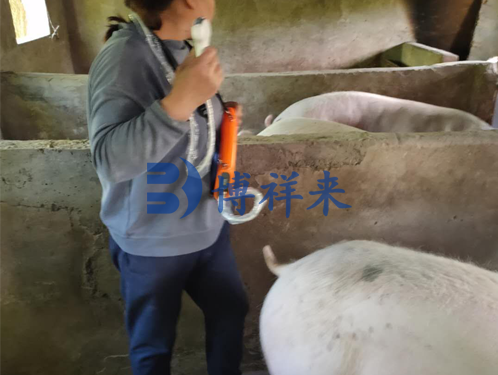Pork producers and managers usually give sows a subjective condition score based on their physical condition, which is used to guide their feeding methods during pregnancy. The problem is that the push for more streamlined genetic lines has resulted in less noticeable compositional changes in popular sow lines.
Using B-ultrasound machine to measure the backfat of sows

The detection of backfat thickness (BF) by B-ultrasound machine in pigs is a routine measurement parameter in many sow farms, and monitoring its changes throughout the entire production cycle can be explained as an indicator of physical reserve mobilization or recovery. Backfat thickness is usually measured at least during weaning/mating, after pregnancy examination, and upon entering the delivery room.
As is well known, sows with very low or very high backfat thickness at the end of lactation may experience reproductive problems, while the latter are usually weaned piglets with lighter body weight.
The measurement of backfat thickness after a positive pregnancy test is a particularly important factor in determining how to group sows that cannot be fed alone during the remaining period of pregnancy on farms.
If there is excessive backfat thickness in late pregnancy, it can affect delivery and reduce feed intake and piglet growth during lactation. In addition, it is particularly important for primiparous sows because backfat thickness is related to sow lifespan; Reserve sows with a certain range of backfat thickness have a higher number of production cycles. Some authors suggest that the ideal backfat thickness range for reserve sows is between 16 and 20 millimeters, although this range may vary and is clearly influenced by sow genetics. On the other hand, the thickness of backfat during delivery seems to be related to breast development and milk production potential, especially in primiparous sows.
In the late stage of pregnancy in primiparous sows, higher backfat thickness often increases litter weight gain, as higher milk production may be associated with better mammary gland development and preparation. However, considering that the improvement in piglet weight gain is moderate (8.5%), for the same live weight, thicker sows will lose more backfat thickness, and the best correlation between backfat thickness and parameters measured in the breasts occurs in non parenchymal tissues. The authors recommend feeding primiparous sows within a backfat thickness range between>15 and<26 at the end of pregnancy.
In practice, to achieve maximum productivity, it is necessary to optimize the current sow's ability to estrus after weaning. The higher the milk production, the faster the growth of the litter, the inhibited ovarian activity during lactation, and the better ovulation and estrus after weaning. The better ovulation and estrus, the easier it is to achieve good mating, and the more piglets will give birth in the future. Accepting this argument, the key to achieving good production levels is to maximize milk production. Among common livestock breeds, goats have ideal breasts with very little fat, resulting in a very high milk production and a very thin body. Considering this and the evolution of sows in recent decades, it can be inferred that slimmer sows have higher productivity. However, for very thin sows, the margin of error in mobilizing body reserves during lactation is very small, and the risk of excessive tissue loss may endanger the estrus of sows after weaning, and even damage their reproductive lifespan. Undoubtedly, in today's sows, backfat thickness (used as an indicator of their energy balance) has lost its importance as a reserve indicator for the sow's body, favoring lean tissue, which best represents the sow's LW. However, for the entire pig population, especially primiparous sows, the backfat thickness of sows (used as an indicator of their energy balance) has lost its importance as a reserve indicator of sow body, in favor of lean tissue best represented by sow LW. However, for the entire pig population, especially primiparous sows, the backfat thickness of sows (used as an indicator of their energy balance) has lost its importance as a reserve indicator of sow body, in favor of lean tissue best represented by sow LW. However, for the entire pig population, especially primiparous sows, backfat thickness remains an important and very useful parameter for assessing physical reserve status; Among other reasons, it is easier to measure than LW under current commercial conditions.








